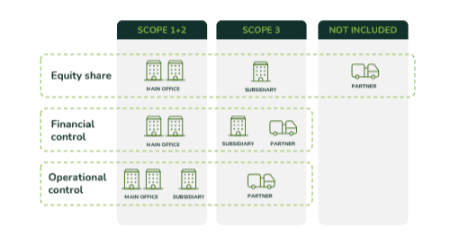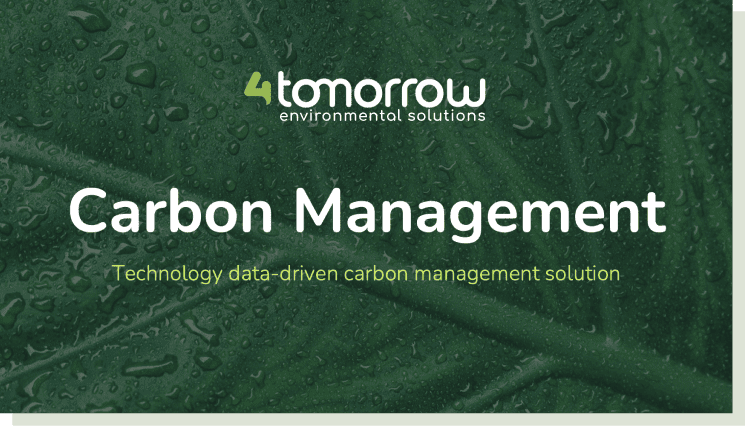Carbon Accounting Methodology
Methodology Overview
4tomorrow uses the GHG Protocol Corporate Accounting and Corporate Value Chain (Scope 3) Reporting Standard. These are aligned with the principles of comprehensive corporate emissions disclosure found in the GRI Sustainability Reporting Standards. We also reference and adhere to various international standards such as the Task Force on Climate-Related Financial Disclosures (TCFD), and region-specific standards such as Climate Active & Toitū. We use various emissions factor databases (MRIO, EEIO & LCA), which are constantly updated to asses spending and activity-based data supplied by the client to understand the organisation’s carbon emissions (C02e) and carbon intensity by vendor or activity to develop an emissions reduction strategy that aligns with Science Based targets (SBTi). SBTi’s provide resources guiding how inventory accounting approaches should inform target setting based on climate science.
Methodology Elements
Carbon accounting principals:
- Relevance: Select the appropriate emissions sources, data and inventory boundaries that reflect the GHG impact of the entity and its value chain
- Completeness: Identify and account for all relevant emissions sources and activities within the inventory boundaries (Scope 1,2 & 3). Where exclusions are required, they are disclosed and justified.
- Consistency: Use consistent methodologies and assumptions over time. Any changes to methods are to be documented.
- Transparency: Disclose all relevant methodologies, data sources and assumptions to ensure an auditable trail
- Accuracy: Reducing and quantifying uncertainties as far as possible. Achieving sufficient precision to enable intended decisions
Boundary setting:
Boundary setting is a key concept in carbon accounting. It is clearly defined in the GHG Protocol for Corporate Standards, which defines the scope of activities included and excluded from your organisation’s emissions inventory. There are 2 main approaches;- Financial Control: All operations where the organisation has the full authority to introduce and implement policies and measures are included.
- Organisational Control: The organisation includes emissions from operations based on financial ownership – where it has the ability to direct financial policies to gain economic benefits.


Accurate boundary setting is crucial as it supports completeness and transparency in accounting reporting and prevents misleading findings by shifting emissions off an organisational inventory.
Adhering to GHG Protocols, companies must include Scope 1, 2 and relevant Scope 3 emissions.
Scope 3 emissions are identified in 15 categories and must include ‘purchased goods & services’.
Assessing the relevance of remaining Scope 3 emissions adhere to the following principles outlined in the GHG Protocol Corporate Value Chain Accounting and Reporting Standards.
4tomorrow currently does not cover:
- Category 10. Processing of sold products
- Category 11. Use of sold products:
- Category 12. End-of-life treatment of sold products:
- Category 15. Investments
4tomorrow relies heavily on the data supplied by our clients, we asses the data using the following approach
- Relevance: Evaluate if the category contributes significantly to absolute or sector emissions. Consider business goals.
- Magnitude: Assess the size of emissions for each category relative to the total inventory. Set significance thresholds.
- Influence: Consider the potential to influence category emission reductions. Greater influence increases relevance.
- Risks: Categories with financial/strategic/climate risks should be deemed relevant.
- Stakeholders: Relevance noted by stakeholders indicates importance.
Where primary activity data has gaps or inaccuracies that limit calculation accuracy, 4tomorrow will employ robust data quality checks and conservative estimations based on historical data trends and benchmarks to maintain compliance with completeness principles to avoid underestimating emissions
Emissions identification & Calculation:
Once organisational and operational boundaries have been established, the next key step is to identify emission sources and accurately calculate the greenhouse gas emissions associated with activities within the inventory.
4tomorrow covers:
Scope 1: Direct emissions (fuel used by facilities and vehicles)
Scope 2: Indirect emissions (electricity usage on-premises)
Scope 3: Upstream & downstream emissions (excluding category 11. Use of Sold Products, 12. End-of-life Treatment of Sold Products & 13. Downstream Leased Assets)
The GHG Protocol defines a simple formulae to calculate each emission in each category according to what input data is available.


- Activity-based Approach: Calculates emissions based on the raw data that can be specifically quantified into emissions data. This approach is the most accurate as it removes any estimations or assumptions.
- Spend-based Approach: Uses financial expenditure on purchased goods/services to estimate emissions using economic input-output emission factors per dollar spent. These factors can come from various databases. 4tomorrow, we will apply the data set best suited to the activity and region to get the best estimate of carbon emissions


Emissions reduction strategy:
Tracking and reporting:
Once a comprehensive GHG emissions inventory has been quantified, the next important element of 4tomorrow’s carbon accounting process is establishing procedures for routine tracking of emissions data and progress indicators.
Key elements of 4tomorrow tracking and reporting are:
- Collect quarterly activity data and recalculate inventories annually at a minimum.
- Maintaining an internal GHG information management system to track performance over time
- Identifying a base year and setting GHG or STI’s targets to assess progress over time
- Establishing and monitoring performance indicators for defined goals and strategies related to emissions reductions
- Disclosing all methodologies, significant uncertainties, and changes to inventory boundaries, methods or other relevant factors in public reports
